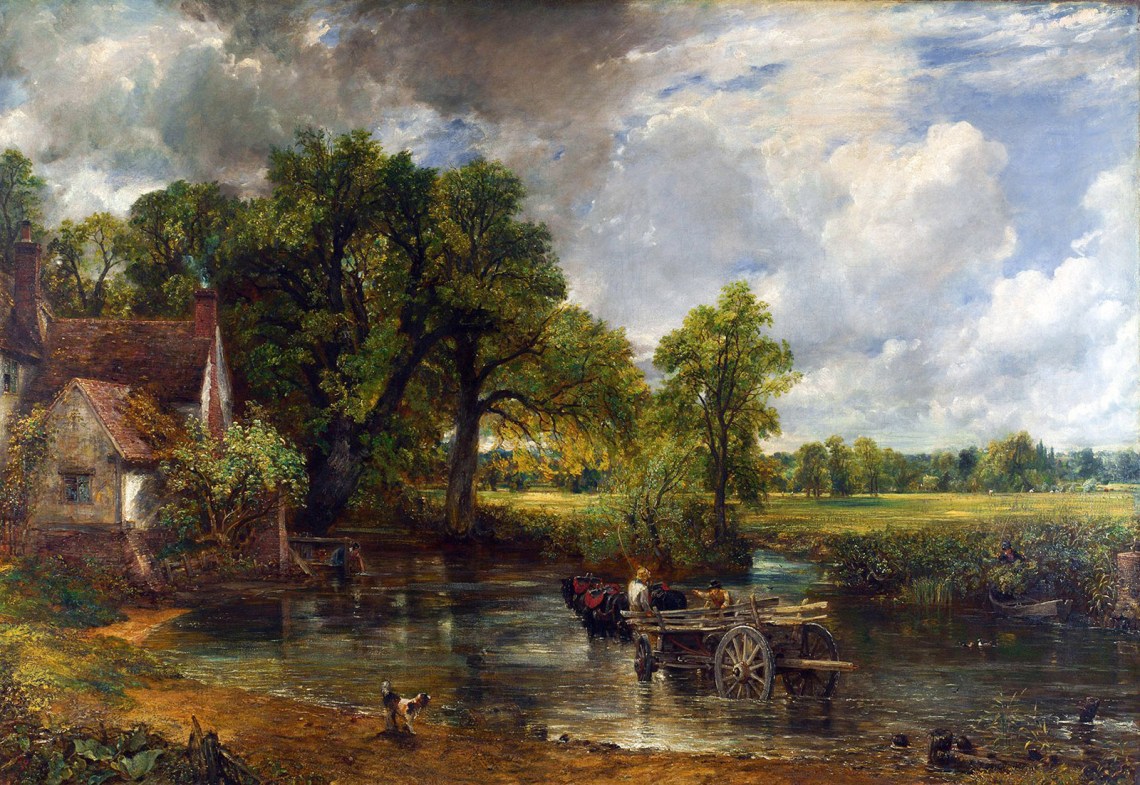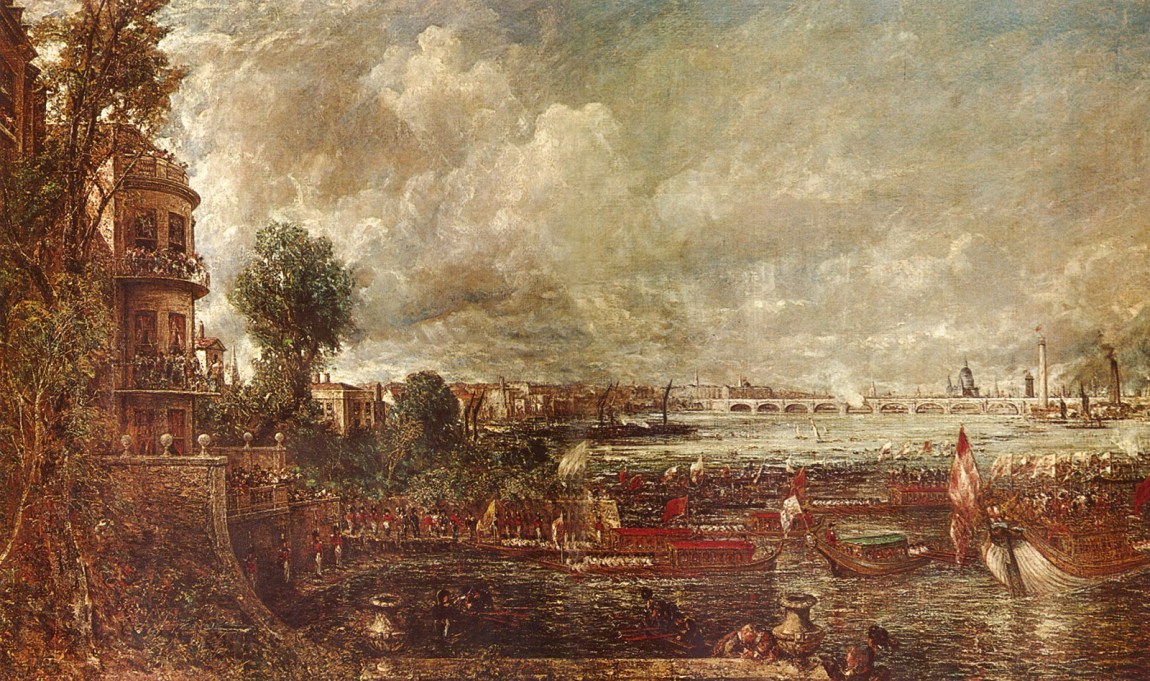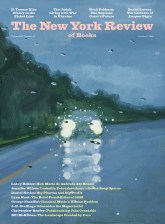What do John Constable’s seductive paintings—those cunningly constructed scenes of English rural life set among majestic trees and canopied by clouds—mean to us today? A possible answer was offered by a pair of environmental activists from Just Stop Oil who entered London’s National Gallery on July 4, 2022, and glued their hands to the gilt frame of Constable’s The Hay Wain (1821). The six-foot painting depicts a horse-drawn wagon (or wain) under the guidance of a man and boy crossing a mill stream. A spaniel walks warily along the bank while a woman draws water from the shimmering shallows. Storm clouds gather above the billowing trees. In a BBC poll in 2005, The Hay Wain was voted the second-most-popular painting in Britain, behind J.M.W. Turner’s contrastingly militant The Fighting Temeraire (1839), a tribute to a victorious ship from the 1805 Battle of Trafalgar. Constable’s much-loved masterpiece, a favorite of makers of jigsaw puzzles and chocolate boxes, would seem to embody a vision of rural peace and plenty, before the depredations of the Industrial Revolution and the rise of Big Oil.
Over Constable’s canvas the Just Stop Oil activists taped an updated version, in which the winding river Stour, in the artist’s native Suffolk, is replaced by an asphalt highway. Fossil-fuel-consuming jets festoon the sky, and smokestacks line the horizon. “You can forget our ‘green and pleasant land,’” one of the protesters, the twenty-three-year-old Hannah Hunt, proclaimed, “when further oil extraction will lead to widespread crop failures. So yes,” she added defiantly, “there is glue on the frame of this painting but there is blood on the hands of our government.” Hunt was quoting from “Jerusalem,” the short poem in which William Blake (an admirer of Constable) warned that the “dark Satanic Mills” of the Industrial Revolution posed a threat to “England’s green & pleasant Land.”
And yet it seems unlikely that Constable—whose father, Golding, was a prosperous coal merchant and owned water mills for grinding grain (including the mill at Flatford, where The Hay Wain is set)—shared Blake’s sense of alarm. In six large-scale paintings set along the Stour, he insisted on including both his father’s mills and the green and pleasant land, as though industry and agriculture could exist in harmony. As in all pastorals, there is an element of fantasy in these serene depictions, which portray a world partly remembered from Constable’s childhood and partly invented from the conventions of art history, in this case the carefully balanced landscapes of Nicolas Poussin and Claude Lorrain. You would hardly know from a painting like The Hay Wain that the English countryside, including Golding’s property, was the site of food riots, arson, and labor strife during the unsettled aftermath of the Napoleonic Wars, when the British economy was in shambles.
Or maybe we have to look a little more closely for symptoms of underlying trauma, as well as for the inherent strangeness of so many of Constable’s paintings. Consider, for example, The White Horse (1819), which depicts the same setting as The Hay Wain but from a different vantage point. The artist William Kentridge, in one of a series of books from the Frick that pair a contemporary artist or writer and a Frick curator to comment on a specific work from the museum’s collection, offers another answer to how such pictures might speak to us today. As a South African of Jewish background, Kentridge feels “a double exclusion” from such rural idylls, having experienced “a childhood not in Constable country, and an awareness…of being outside the automatic assumptions of vicarage, church, christening.”
Kentridge zooms in on the puzzling detail of a draft horse standing stolidly on a barge as three men struggle to push it forward. (The horse is being transported from one side of the canal to the other, where the towpath continues.) Noting that Constable was a contemporary of Francisco Goya, Kentridge aligns The White Horse with Goya’s etching, from his Proverbios series, of a horse balancing on a tightrope. Both artists were working amid the fallout from Napoleon’s Peninsular War, Kentridge notes, and “there is something of the indignity of a horse on a boat similar to the donkeys carried by men on their backs in Goya etchings and the tightrope-walking horse.”
Kentridge’s suggestion prompts a larger question: Was Constable a backward-looking nostalgist lamenting the bygone comforts of Little England? Or was he instead the pathbreaking revolutionary celebrated by painters from Eugène Delacroix to Lucian Freud, who once called The Leaping Horse (1825), another in the Stour series, “the greatest painting in the world”?
In his spirited if somewhat conservative biography, James Hamilton—a well-traveled curator and the author of a widely admired life of Turner, Constable’s great contemporary and artistic rival—adopts the view, shared by many other art historians, that the monumental paintings set on the Stour are the heart of the artist’s achievement. Hamilton is particularly attentive to Constable’s close ties to his rural origins, and to the ways in which these paintings can be seen as celebrations of the family business, which consisted of a complicated economic loop of mills, barges (the building of which, by the Constable firm, he depicted in a superbly detailed painting), and a lucrative trade in corn and coal, all overseen by Golding, a “kind employer” whose workers were “trusty, constant, inventive,” according to Hamilton. The upper-middle-class Constables were “almost a family of fiction,” he writes affectionately; “Jane Austen springs obviously to mind.”
Advertisement
The primary drama of Hamilton’s narrative is Constable’s lifelong struggle, amid various forms of resistance, to convey his deep feelings for his native countryside to a reluctant public, which preferred escapist historical tableaux and portraits of grandees. For Hamilton, Constable, born in the hamlet of East Bergholt in the revolutionary year of 1776, is a quintessential Romantic artist, seeking, like his friend William Wordsworth, the artistic means to register his attachment to particular places. “I should paint my own places best,” Constable wrote in a famous letter, specifying the evocative power of “Willows, Old rotten Banks, slimy posts, & brickwork.” There is something almost Proustian in this act of imaginative retrieval—to give, as Constable wrote, “one brief moment caught from fleeting time a lasting and sober existence.”
Plagued by anxiety and indecision, Constable was slow to separate himself from the expectations of his parents, who regarded his passion for drawing the local landscape as a hobby, not a proper vocation. When it became clear that he would not take over the family business, they noted that portraiture and church decoration could provide a steadier income than landscape painting, which was seen as a modest genre best suited to celebrating picturesque views on country estates. Constable could be a brilliant portrait painter, as in his deft and gender-bending snapshot of his two contrasting sisters: dashing, androgynous Ann in a stylish riding outfit and Mary in an Empire-waisted white dress. But his emotional anchorage was in those slimy posts.1
Constable’s courtship of Maria Bicknell, a brilliant young woman with East Bergholt connections, was delayed—“seven years of pussy-footing,” in Hamilton’s unfortunate phrase—by her family’s doubts about his financial prospects. When they finally married, Constable, who habitually wore black, suggested that his bride do the same at their wedding to save money. (She wore white.) They made up for lost time by having seven children in eleven years, a delight for Constable but an ordeal for the tubercular Maria, who, despite repeated sojourns in Brighton for the sea air, died in 1828 at the age of forty-one.
Constable could work with incredible speed in drawing a cluster of trees or a windblown cloud (as in his astonishing cloud studies, part meteorological observation and part hallucination), or in making a postcard-size oil sketch in anticipation of a larger painting, yet he could also make excruciatingly slow progress on the large-scale paintings (his “six-footers”) that he wished to be his legacy; the panoramic and opulently colorful The Opening of Waterloo Bridge, for instance, sat on his easel for thirteen years. His quixotic commitment to pure landscape also delayed his election to the Royal Academy, the stuffy official institution that did not confer full membership on him until—after multiple failed attempts—he was elected in 1829 at the age of fifty-two. Turner, by contrast, was only twenty-six when he became a full academician in 1802. Constable emerges in Hamilton’s pages as a deeply conflicted person, loyal to friends, competitive with rivals, and capable of being “chippy, touchy, hypochondriacal, sarcastic, gossipy, libidinous, tight with money.”
On one of the legendary occasions in art history, however, Hamilton thinks Constable’s irascibility has been exaggerated. In 1832 Constable and Turner were putting finishing touches on their entries for the annual Royal Academy exhibition. Noting that Constable’s (finally finished) Waterloo Bridge made his own marine painting Helvoetsluys seem pallid by contrast, Turner “blobbed a brush-load of red” on the crest of a wave. “He has been here and fired a gun,” Constable remarked. The blob of red paint, later converted into a buoy, has generally been seen (in Mike Leigh’s 2014 film Mr. Turner, for example) as a pointed insult. Hamilton, however, makes the not-altogether-convincing suggestion that it might have been a compliment instead to Constable’s skill in exploiting color contrasts. Turner, with his red blob, was merely “doing what Constable might have taught him, a vivid demonstration of how together the reds became redder and the greens greener.”
Advertisement
Unlike the cosmopolitan Turner, who painted dashing scenes of Venice and Cologne, Constable never traveled abroad and spent much of his life shuttling between Suffolk and London. “I hope not to go to Paris as long as I live,” he sniffed. And yet he never found during his lifetime the large English audience he had hoped for, even when he prepared a set of engravings—marketed as English Landscapes—based on his paintings. It is a measure of the tepid response Constable continued to receive in England that The Hay Wain went unsold when it was first shown, in 1821, at the Royal Academy.
And then, in one of the astonishing turnabouts in art history—comparable to the enthusiastic reception of Edgar Allan Poe among avant-garde French poets—certain French viewers were overwhelmed by The Hay Wain. Théodore Géricault, who had come to London to exhibit his Raft of the Medusa (1818–1819)—a huge painting depicting a horrifying event in French colonial history, with a black man in a central role—was “quite stunned by” The Hay Wain. After a French dealer bought the significantly discounted painting, it was shown in the Paris Salon on the walls of the Louvre, where another great Romantic painter, Delacroix, was so moved that he sought out Constable’s studio in London.2 Delacroix, who reportedly revised his famous Massacre at Chios (1824) according to what he’d learned from Constable’s methods of exploiting color contrasts, later called the Englishman “the father of French landscape painting.”
It can be difficult for a gallerygoer today to understand how Constable’s seemingly quiet paintings, in which nothing dramatic appears to be happening, could have lit a fire under painters like Géricault and Delacroix. How could laborers struggling with a barge or releasing a recalcitrant canal lock match the lurid, action-filled tableaux of narrative paintings like Delacroix’s The Death of Sardanapalus (1827)? Even Constable’s most appreciative supporters worried about the lack of drama in the paintings. “It is most pleasing when you are directed to look at it,” his closest friend, Archdeacon John Fisher, wrote in 1812, thanking Constable for the gift of a painting. “But you must be taken to it. It does not solicit attention. And this I think is true of all your pictures & the cause of your want of popularity.”
One way to solicit attention was to paint bigger canvases. Constable developed a distinctive and unprecedented process for doing so, which, according to the Frick curator Aimee Ng, in the essay paired with Kentridge’s in Constable’s White Horse, has “captivated and mystified scholars.” Despite the considerable outlay in canvas and paint, not to mention studio space, Constable would paint a full-size oil sketch for each of his monumental paintings. These six-foot sketches—often more treasured today by connoisseurs and artists than the final versions—were executed with greater freedom in their brushstrokes and more startling color juxtapositions. To a contemporary eye, these sketches seem to prefigure the radical stylistic innovations—the broken brushstrokes and clashing colors—of Monet or even Van Gogh (as Lucian Freud suggested), and one may wonder what a painter like Delacroix might have thought of such innovative works had he seen them.
Constable increasingly adopted this freer style in his finished paintings, which became more adventurous, more gestural, more abstract. After the death of his wife, they also became darker. “Every gleam of sunshine is blighted to me in the art at least,” he wrote a friend in 1834. “Can it therefore be wondered at that I paint continual storms?” Wielding a palette knife with slashing abandon, he summoned “almost abstract splashes of pure pigment,” according to the conservator and Constable scholar Sarah Cove. With his “wild use of thick impasto and flecks of pure colour,” this “Jackson Pollock of the 1830s,” she writes, created works “extraordinarily modern for their time.”
Was this radical change in style “fuelled by a great well of emotion,” as Cove suggests, or was it part of a natural progression in vision and technique? In the catalog essays for “Late Constable,” an exhibition at the Royal Academy of Arts, London, which ran in late 2021 and early 2022, Anne Lyles and Matthew Hargraves, along with Cove, take 1825 as the turning point in Constable’s art. This was the year he painted The Leaping Horse, the sixth and last of the Stour six-footers. The painting, which depicts a barge-horse leaping over a barrier erected to prevent cattle from straying, gave Constable a great deal of difficulty, with multiple preparatory sketches as well as multiple revisions after it was exhibited, unsold, at the Royal Academy.
The Leaping Horse reveals two kinds of distortion new to Constable’s art. First, there is what Lyles calls “distortion of topography,” as Constable (a devout Anglican) added a church tower on the horizon not visible from the depicted viewpoint. Second, there is a distortion of treatment, both in the preparatory drawings—which Hargraves describes as “splendidly unlovely sheets: rough, urgent and blotted with hasty invention”—and in the aggressively reworked canvas, which Constable attacked, after bringing it back to his studio, with large-bristle brushes and a palette knife. He gave particular attention to the trees, moving a pollard willow from one side of the horse and rider to the other, to give more dynamism to the leap, and extending the height of a large tree so that the tips of its branches nearly touch the top of the canvas. Kentridge praises Constable’s “heroic” struggle “to make his portraits of trees as significant as the portraits of generals or dukes.”
There had always been an elegiac quality in Constable’s work, a nostalgic longing for the orderly world he remembered. But there’s a more palpable sense of loss in his later paintings, and a gothic turn in the mood, as trees and clouds (always Constable’s true subjects) increasingly overwhelm the human presence—those mere “bit players,” as Kentridge notes, in Constable’s visual theater. In the full-size sketch of Hadleigh Castle (1829), the turbulent, rook-delighting sky over the roofless ruins suggests the morning after the apocalypse. The Cenotaph (1833–1836), one of Constable’s last exhibited works, draws us into a woodland allée of lime trees sheltering a startled stag, flanked by marble busts of Michelangelo and long-haired Raphael. A memorial to Sir Joshua Reynolds, the longtime head of the Royal Academy, is the focal point. “Absent is the joy in landscape and open air and sky and cloud,” Hamilton observes, “and the ever-present hint of people.” This dark-hued painting with its insistent memorial theme recalls the epic wastelands of Anselm Kiefer.
Constable’s bleak, depopulated watercolor Stonehenge (1835) was paired with The Cenotaph in his final showing at the Royal Academy. Such paintings can be seen to foreshadow W.G. Sebald’s desolate, postindustrial circuit of Constable’s native region. In The Rings of Saturn, Sebald notes the Martello towers strung along the Suffolk shoreline, erected to repel an invasion by Napoleon’s troops, and the eerily abandoned cold war military installations—“like the tumuli in which the mighty and powerful were buried in prehistoric times”—on the island of Orford, in the same estuary through which Constable’s father sent his laden barges toward London. “The closer I came to these ruins,” writes Sebald, “the more I imagined myself amidst the remains of our own civilization after its extinction in some future catastrophe.” In Constable’s late paintings, we could almost have strayed into such a post-human landscape, as William Blake feared, and as the Just Stop Oil protesters, hands glued to The Hay Wain, warn us.
-
1
Slimy posts appear in the foreground of all six Stour paintings, leading the art historian Ernst Gombrich, whose Art and Illusion is framed by considerations of Constable’s work, to gesture toward Freud, especially when Constable notes, after passing more slimy posts near an old mill, “I wish you could cut off and send their tops to me.” Gombrich says no more (“Little need be added to his words in this century of Freud”), but presumably he takes the posts to be phallic. ↩
-
2
Delacroix noted Constable’s revolutionary use of color combinations: “Constable says that the richness of the green in his meadows comes from his use of many different greens. The dullness in the green in the verdure painted by other landscape painters is that they tend to use a single tint. What he says about meadow green can be applied to all other tones.” ↩





